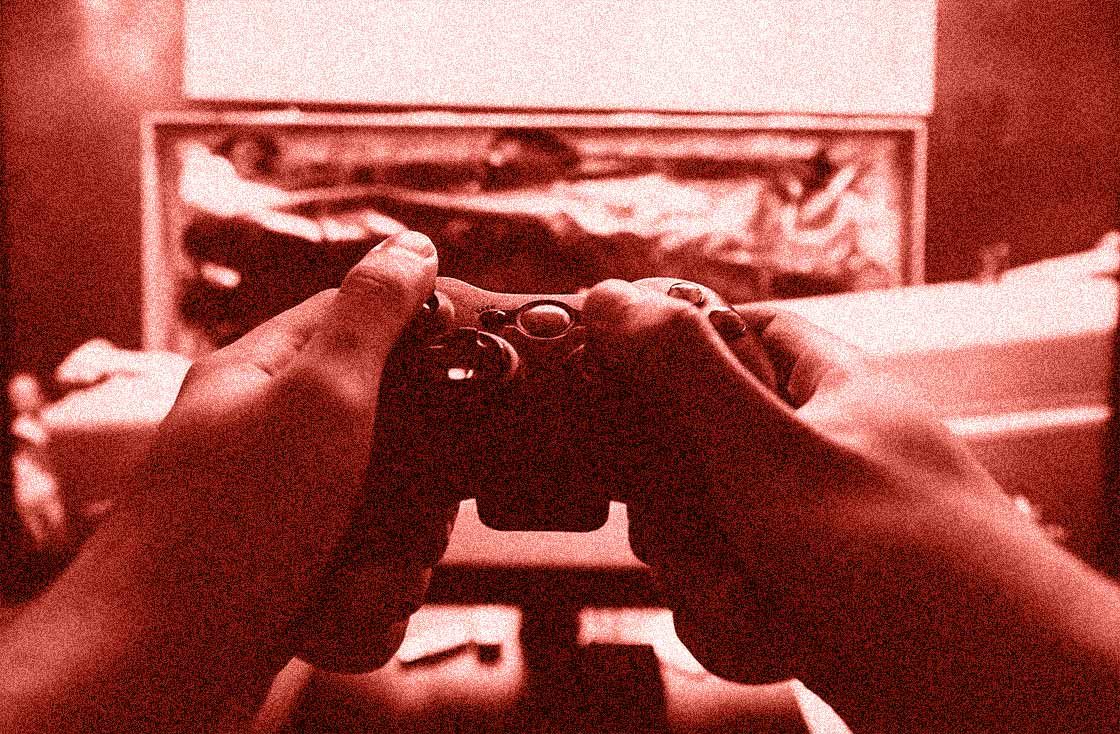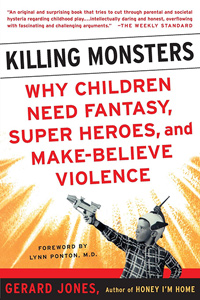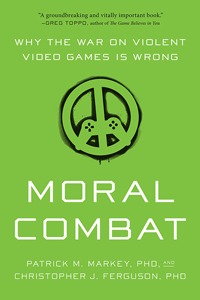Video games, especially so-called “violent” games, are the latest in a long string of new entertainment media to be accused of “ruining the youth of America.” Video games as the cause of all sorts of societal ills have been preceded by dime novels, comic books, violent TV shows, and movies and songs with sexy or racy lyrics. In 2002, Gerard Jones published Killing Monsters: Why Children Need Fantasy, Super Heroes, and Make-Believe Violence (Basic Books), the first book, as far as I know, to critically examine the hysteria over alleged effects of make-believe violence in the media on children. It focused on all media, not just video games, and concluded that such media posed no threat.
Since Jones’ 2002 book, video games, especially violent video games (hereinafter VVGs), have been the focus of worry that VVGs lead to adolescent violence, even school shootings (think Columbine), and are as addictive and dangerous as drugs. Markey and Ferguson show in their new book Moral Combat that not only are video games, even the violent first-person shooter games, innocent of the charges made against them, video games can and do have positive influences on their players. The authors begin with a brief history of video games and other supposedly harmful media. For example, psychiatrist Fredric Wertham, a crusader against comic books, believed that comics caused juvenile delinquency and that Batman and Robin encouraged homosexuality. His 1954 book Seduction of the Innocent (Rinehart) was an important part of the crusade against comics. It turns out that Wertham “overstated and potentially even fabricated much of his data” (p. 32) that he used to castigate comics.
The crusade against video games is a moral panic akin to that seen in the panic over ritual satanic child abuse.
Markey and Ferguson argue, correctly in my view, that the crusade against video games is a moral panic akin to that seen in the panic over ritual satanic child abuse. Throughout the book they make the interesting point that the crusade is led by those who have little familiarity with the video games they attack, the gamers involved, or the gaming culture that has grown up around the games. They note that the researchers who do research aimed at showing the games’ deleterious effects are largely older individuals who have little knowledge of the gamers or contact with the gamers.
The anti-game moral panic has been heavily fueled by laboratory studies that purport to show that playing VVGs leads to increased aggressive behaviors. It was these studies that led to condemnation of the games by such organizations as the American Psychological Association. The APA group that wrote the condemnation of games was packed with anti-game researchers who evaluated their own research. Certainly nothing could be fairer!
The research on which the condemnation was based was shoddy. The laboratory conditions under which games’ effects were tested were very different from playing in the real world. Typically, gamers played a game new to them for a short period of time. They were then given some test of aggressiveness. As gamers know, playing a new game can be frustrating at first. When other studies controlled for the frustration effects, the so-called aggression effects went away. I say “so-called” because the measures of aggression were, to say the least, unrealistic. Subjects who played games were “more likely to expose others to loud, irritating noises, report feeling more hostile on a questionnaire, give longer prison sentences to hypothetical criminals” or, my personal favorite, “give hot sauce to people who do not like spicy food” (p. 54). Happily, the great popularity of VVGs seems not to have resulted in a rash of miscreants sneaking around surreptitiously putting hot sauce in innocent peoples’ meals. I’m so relieved!
By far the most serious charge against VVGs is that they are involved in school shootings, the worst being the 2012 slaughter of 20 children by Adam Lanza. At least one uninformed initial comment from law enforcement held that Lanza thought that carrying out the shooting would be like accumulating points in a VVG. In fact, Lanza did play a video game with what might be called obsessive interest. But it wasn’t a violent one; it was a dance game, Dance, Dance Revolution, in which the player gets points for being a better dancer. The reality of the relationship between VVGs and school shooters is the exact opposite of the school shooter stereotype. School shooters are much less likely to have been involved in VVGs than normal, non-shooters. Nonetheless, this stereotype has been ensconced in lists of “warning signs” of possible school violence.
The finding that shooters are less likely than others to play VVGs leads naturally to the question of why this is so. After all, if shooters are alienated loners and game players are also loners, shouldn’t shooters be game players? The answer to this seeming contradiction is that game players are far from the social isolates that older observers and non-gamers perceive them to be. Certainly, there are those individuals that live in their mother’s basement playing games all day. But they are the exception. Especially as gaming has become more popular, it has evolved into a much more social activity in which multiple gamers can play together. The authors describe research that shows “that most games are played in very functional social networks and are in fact social outlets for the people who play them” (p. 174) and that “particularly young people use video games to develop and maintain friendships” (p. 175). A quick Google search showed that there are numerous video game clubs (called meetups) and on-line newsletters for and about games and gamers. This sounds to me very much more social than that very socially approved hobby that I spend a good deal of time (and money) on—stamp collecting.
As if school shooters weren’t bad enough, video games are also said to be addictive, like a drug, even releasing quantities of dopamine when gamers play. In an outburst of hysteria typical of moral panics, on July 8, 2014 the British newspaper The Sun stated that video games were “as big a health risk as alcohol and drug abuse.” Does playing video games release dopamine? Of course it does. So does any other fun and pleasurable pastime. But the amount of dopamine released in gaming is dwarfed by that released by drugs. Drug addiction is qualitatively and quantitively different from game playing.
Having said that, do some gamers spend too much time and money on their games? Of course they do. And that can be a problem. But compare gaming to stamp collecting, as I did above. I’ve collected stamps since I was in grade school, as many did then. I spent a great deal of time playing and working with my stamps, and I was a bit of a loner for it. I know adults who fit the loner profile. I knew of children and adults who stole to support the philatelic habit. And I’m sure I get a nice squirt of dopamine in my nucleus accumbens when I finally obtain a desired stamp for my collection. And yet, during the heyday of stamp collecting, no one condemned it as a dire threat to the youth of America.

This article appeared in Skeptic magazine 22.4
Buy print edition
Buy digital edition
Subscribe to print edition
Subscribe to digital edition
If games have no real negative consequences for the great majority of players, do they have any benefits? The answer here is yes. I noted above that modern gaming is a very social activity. It may help bring individuals who would otherwise be loners out of their shell and help them learn to interact with others as they engage in an enjoyable social activity. As to claims that game playing has beneficial cognitive effects for the young and the elderly, the evidence is less clear. My read is that there is some data showing that game playing may improve motor coordination, which is nice. As to claims that brain-training games can improve cognitive function in the aged or even slow down Alzheimer’s Disease, not only do these claims lack any evidential support, there is much evidence that they are false. It is true that playing a specific game makes you much better on that specific game, but there is little or no transfer of learning to other situations. The entire brain training industry is selling electronic snake oil.
Moral Combat presents a thorough and well-referenced look at the actual effects of video games. The writing is never pedantic and is often humorous. It is an enjoyable and informative read. In the end, it is clear that video games, violent or otherwise, don’t need to have large beneficial effects to justify their existence and use. They just need to be harmless fun, which they are. ![]()
About the Author
Dr. Terence Hines is a cognitive neuroscientist and professor at the Psychology Department, Pace University, Pleasantville, NY and adjunct professor of neurology at New York Medical College in Valhalla, NY. His research focuses on paranormal belief, the cognitive representation of numbers and, when he has time, the nature of bilingual memory. He is the author of Pseudoscience and the Paranormal. He received his undergraduate education at Duke University and his Ph.D. from the University of Oregon. When not cogitating about brain stuff, he transforms into a student of how data from local postal activity of the 19th century in the US can illuminate the economic history of that time period.
This article was published on February 6, 2018.


















I think you hit the nail on the head with this:
“The type of behaviors that are taught to resolve problems are incongruent with reality.”
Gamers know the difference between the games they play and real life. Even young children are aware of the differences between the toys they play with and the living creatures around them.
Young men are violent because it’s in our DNA. Violence is a pro-social behavior in defense of territory and possessions and antisocial when it degrades social bonds in the group. In tribal society, inappropriate violence is suppressed by social punishment – either physically or via social deprivation such as shunning or banishment.
To the direct issue of video games and movies increasing violence, it is a two-fold canard. First, there is no direct connection between vicariously watching a violent act and actually performing an act of violence. Watching is not doing. Doing requires several other processes that are absent from merely watching something. I see people drive unsafely on a regular basis but have no interest or propensity from driving recklessly.
Second, it is the absence of contingent punishment for antisocial violence that is causing an increase of violence in our culture. Contingent punishment is the process whereby behaviors are stopped and inhibited from a future recurrence.
The Gold Standard of contingent punishment is a cactus needle. You touch it once and you instantly learn to never do it again. What contingent punishment exists in our culture for the uptick in male violence? Almost nothing. In fact, young males are socially punished for any form of arousal, whether in sports or social interactions – but there are NOT punished for things they actually do. They are punished for being male and doing things that are innate.
The move toward a fusion of normative hedonism and Cartesian dualism is responsible for this disintegration of civil behavior. Those two philosophies, once fused, destroy society’s ability to suppress many things, but violence, especially. No punishment, no inhibitions.
EG: At the Berkeley Riot, there was a young woman desperately trying to smash a window (fruitlessly) with a baseball bat. If you unmasked her, you would see someone never punished for that kind of behavior. Ergo, she was perfectly capable of a natural behavior that had never been inhibited. I seriously doubt she had ever played a video game that triggered her violence.
Instead of learning the properties of punishment, behavioral scientists, educators and social scientists oppose any use of aversive control, regardless of outcome…other than their pervasive, Utopian use of it to reshape society to their distorted world view. The formula for bad endings is positive reinforcement (like the kind that bat-wielding woman likely received after her foray into revolution) in the absence of contingent punishment for antisocial or dangerous behavior. True fact.
I have done a couple of papers in this area and I have done a meta research and there are several reasons why it makes sense that Violent Video Games (VVG) are a negative influence in children and adolescents.
– These games provide a very immersive environment, that is conducive to learning and depending on the age to incorporate in unconscious procedural memories.
– If you add VR to this immersive environment the influence will be even greater and more effective to teach these foreign values.
– The type of behaviors that are taught to resolve problems are incongruent with reality. There is a strong cognitive dissonance between what they practice here and what happens in the “games”.
– These games have a basic problem resolution process that tends to reward speed and fast reactions. These type of behaviors are the most connected to our limbic/emotional systems and as such they don’t foster use of our most powerful and recent system which is our cognitive integrated with our emotional system working together.
– The experiences that countries in Northern Europe tend to also suggest the negative influences of this learning and value transmission.
– There are hundred and hundred of research studies that have done longitudinal studies that find influence and correlations as the ones I mention.
– In case of doubt would you prefer your children to get exposed to these experiences or would you rather provide them with opportunities to have fun and learn something that motivates and learn?
GW: The analysis here seems a bit superficial to me.
“School shooters are much less likely to have been involved in VVGs than normal, non-shooters.”
GW: This would be a better hypothesis to test: “Degree of participation in VVGs before age 18 has a significant positive correlation with aggressive behavior at age 18 and later, measured in a variety of ways.”
“Having said that, do some gamers spend too much time and money on their games? Of course they do. And that can be a problem. But compare gaming to stamp collecting, as I did above.”
GW: Why not compare gaming to alcohol use, drug use, gambling, obsession with pornography, etc. What are the rates of abuse for these different habits?
Can’t wait to read the book. From the beginnings of the panic over VVGs, I was reminded of Frederic Wertham and the anti-comics crusade and could see parallels with the Parent’s Music Resource Center and their attempts to censor popular music. A good many of my friends and associates who disagree with me on the issue cite the flawed studies in support of their point of view: in my opinion, that’s because they dislike VVGs and video game culture in general and want to believe that there is a link between VVGs and real-world violence.
I am a gamer, and will give you here what I experienced.
People play games that usually fit with their personality, the same way people buy a car that they like. Young drivers that love speed will buy sports cars, and older adults that like expensive things will buy luxury cars.
So, for gamers, aggressive individuals will prefer shooting games while more social gamers will play online games with other gamers. You also have to consider what you are killing on a shooting game: there is a difference between shooting zombies, animals and monsters (which I can easily do) and killing humans by hitting them several times with a baseball bat. I stopped playing a game (Mafia) when I had to do the latter.
It also depends how realistic is the game, and in which setting it is. Killing humans in a war or a medieval setting is not the same as killing them in a game set in the years 2000. The farther you are from reality, the easiest it is to consider it just a game.
It is when the game is too much real, in the present time, with highly defined (high resolution) human character, that you can possibly develop a disconnection with the reality and view killing others as something you may want to do. But this might not be an effect from the game, but the choice of someone already disconnected from the society.
Finally, I have to mention the addiction one can develop with gaming. It is like alcohol. Some people can drink without excess and keep a good social life while others get addicted and withdrawn from society. Remove all the games and those people will find other “hobbies” that may be as addictive and more costly.
Based on my own limited background as a teacher and a parent, I would tend to agree with the study that there is no direct cause of violence from playing violence.
HOWEVER, how many concerned adults would think it okay for teens to play rape or molestation games, even if there is no proof that playing the games leads to rape or molesting children?!
Often, in the violent video games, women are objectified, demeaned, etc. Is that okay, since there is no evidence that such games directly cause the mistreatment of women?
Is it okay to play racist games even though there is no proof that the games directly cause racist attacks?
Etc.
Most children were exposed to fairy tales at some stage of their lives. Some of them are extremely violent. Some may argue that they were never intended for children. They must have been intended for somebody. Evidently, they were meant to describe the world in which the people were living at the time. The Brothers Grimm could be very grim, indeed.
What video game were they playing during the Crusades/ the Salem witch hunts/ both World Wars/Wounded Knee/the Revolution/the Civil War, etc.etc. ad nauseam?
Each time I think I can while away some hours playing a video game, I find only the violent “kill the monster, defeat the enemy knight, shoot the tank” stuff. Does this kind of “play” develop motor skills? It may seem to, until the individual decides he/she can play the same way in live traffic. The exaltation and deification of violence is endemic to our species, and must be recognized as such. Some of us continue living lives of kindness, compassion and tolerance, and playing tennis or chess or “pong” to improve our motor skills. Physical evolution of the species may, or may not, mutate this need to hurt and dominate. Without judging, one can only stand back and offer an alternate example. I hope homo hubrisimus can survive this period of violence.
I am disappointed that there is not any data presented. The incidence of violence in those who have played a lot of first person shooters, versus those who haven’t, is what is the issue. Some numbers one way or the other would prove reassuring. I suspect that most people have decided one way or the other without reviewing data. As a scientist, who has reviewed a lot of misleading or misinterpreted data, or those assuming correlation equals causation, I find it far more reassuring to actually review methods, the questions asked, and who gets into the study in the first place.
The data is in the book.
Any study trying to link playing violent games to actual violence is going to have to deal with the fact that as games have gotten more widespread and more realistic, real world violent crime has plummeted. (See https://www.statista.com/statistics/191219/reported-violent-crime-rate-in-the-usa-since-1990/)
There are obviously a huge number of factors in play, but when you control for them in an actual study, it looks like the effect is actually negative- an increase in video game playing reduces actual violence. (See Markey’s 2014 study: http://interpersonalresearch.weebly.com/uploads/1/0/4/0/10405979/ppmc_-_vvgs_and_real-world_violence.pdf) There’s a lot more to be done in this field, but I have yet to see any evidence of any kind that shows that game players are more likely to commit real world violence than their peers.
Video games are the Reefer Madness of the 21st century
In human apes, mimicry rules. (Why? Because it is so much easier than originating ideas.) A constant stream of violence will be mimicked in behavior. The challenge of real Humans is to overcome the dangers of mindless mimicry and so evolve a more just and compassionate world.
Boys will be boys is like saying alligators will be alligators. Humans have discovered the tools to overcome reptilian behavior and it is a weak argument to claim violent actions will not be mimicked.
Maybe. But this leaves unanswered the question of why young men are so enchanted with violence – pretend or otherwise – and whether this is something that should be encouraged in our society, and whether it is indeed “innocuous.”
I’m guessing its for the same reason that so many animals play fight while growing up – its our nature.
Huh? Young men have been enchanted with violence since, well, since there have been young men. Different cultures have assigned different value to this through history. I don’t see what this has to do with whether video games increase aggression.
Absolutely agree. There is something basic in Human Nature that desires this dominating, killing behavior – researchers are clueless as to what it is, despite their many pronouncements. It feels wrong-thinking, from a Buddhist point of view, which is how I live my life. I am sorry to see so much of it so prevalent for youngsters, but doubt it is remediable at this point in our evolution.
I found this article extremely interesting…by point of comparison, you may wish to review the book “Stop Teaching Our Kids to Kill: A call to action against TV, Movie & Video Game Violence” authored by Lt. Col. Dave Grossman and Gloria DeGaetano – published in 1999….ISBN #0-609-60613-1.
Lt. Grossman is a West Point psychology professor and professor of military science and is viewed as a subject matter expert throughout the law enforcement community.
Cheers